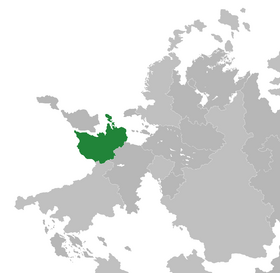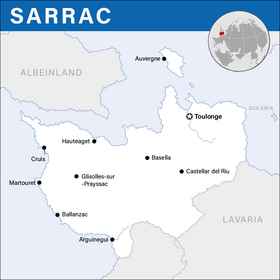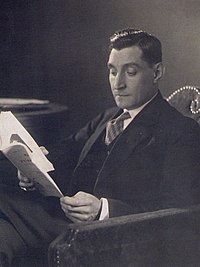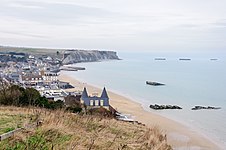Sarrac: Difference between revisions
| Line 226: | Line 226: | ||
==Economy== | ==Economy== | ||
[[File:Peniches sur la Seine a Boulogne P1000112.JPG|230px|thumb|View of the {{wp|central business district}} of Digues, Toulogne, which is considered the second largest of [[Berea]] after [[Köpenick]].]] | [[File:Peniches sur la Seine a Boulogne P1000112.JPG|230px|thumb|View of the {{wp|central business district}} of Digues, Toulogne, which is considered the second largest of [[Berea]] after [[Köpenick]].]] | ||
Sarrac is considered a {{wp|high-income economy|high-income}} {{wp|social market economy|social market}} {{wp|developed economy}}. It is the _th largest in [[Berea]] and the _th per capita, only after _, | Sarrac is considered a {{wp|high-income economy|high-income}}, {{wp|social market economy|social market}}, {{wp|developed economy}}. It is the _th largest in [[Berea]] and the _th per capita, only after _ and _. The country ranks very high in {{wp|Human Development Index}} rankings (0.903 in 2020) and has a comparably low {{wp|income inequality}} as reflected on the {{wp|Gini index}} (27.5 the same year). Regarding its labour market, it has undergone several reforms aimed to erase barriers and make it more flexible for both employers and employees; in this context, Sarrac counted with a low {{wp|union density}} when compared to other Berean nations (13.4% in 2020) but a very high {{wp|collective bargaining coverage}} (90.1% reported the same year). The Sarracese economy is considerably open, although the state still owns considerable shares in key industries related to the energy, telecommunications and transport. | ||
The {{wp|services sector}} comprises most of the Sarracese economy, comprising 78.8% of its total output. It is based around banking and finances, of which the state plays an important role, and sees large contributions from tourism, which is a key sector of the economy for several regions of Sarrac. During 2019, the country saw approximately 78.9 million tourists and the country remains highly connected with neighbouring nations and all continents. The tertiary sector is also composed by important contributions from retail. Sarrac has traditionally counted with a considerably large {{wp|secondary sector}}, in which the {{wp|automotive industry}}, {{wp|shipbuilding}}, {{wp|aeronautics}} and the {{wp|energy production}} lead the sector with companies that count with national, regional and worldwide presence, like {{wp|Peugeot|cars}}, [[Électricité de Sarrac S.A.]] and [[PCSA]]. Non-polluting industries, related to the {{wp|pharmaceutics}} industry and the production of {{wp|technology}} and {{wp|software}} also count with a considerable portion of the secondary sector. | |||
===Infrastructure=== | ===Infrastructure=== | ||
===Energy=== | ===Energy=== | ||
Revision as of 23:35, 6 July 2021
Motto: "Plus loin" Further Beyond | |
 Location of Sarrac in Berea | |
 Map of Sarrac | |
| Capital and largest city | |
| Official languages | Sarracese |
| Recognised regional languages | Zarautzea Cerdanyá |
| Demonym(s) | Sarracese |
| Government | Unitary parliamentary constitutional republic |
| Jean-Marc de Villers | |
• Premier | Jaqueline Leroux |
| Legislature | Parlement sarraçais |
| Establishment | |
• Telmerian consolidation | 400s |
| 850 | |
| 1431 | |
| 1788 | |
• Current Constitution | 1972 |
| Population | |
• 2020 estimate | 42,128,950 |
• 2018 census | 40,035,846 |
| Gini (2020) | 27.5 low |
| HDI (2020) | 0.903 very high |
| Currency | Franc (FRS) |
Sarrac, officially the Sarracese Republic (Sarracese: République sarraçaise) is a country in the continent of Berea. It borders Lavaria to the east and the Arthurean Strait to the north. It is home to 42,128,950 inhabitants and its capital and largest city is Toulogne, a major financial, political and cultural centre of the continent.
During most of Antiquity, the territory of Sarrac would be home to antique Erytherian colonies, especially on its west coast bordering the Sian Sea. Farther north, in the regions that surround the Arthurean Strait, Felghnez tribes’ identity would start to form with Foranic influences from Albish territories, rapidly becoming a threat to these prosperous colonies, often referred to as city-states. During the following centuries, the territory remained subject to Cambran influence. The start of the Middle Ages would see a heavily fractured Sarrac. Cutish migrations over the Albish territory forced the Foranic tribes to extend, once again, across the Arthurean Strait, forming the first Felghnez independent merchant towns settled mostly on the northern tips of Sarrac. These towns would be the first to unify under a single authority becoming a threat to Albish kingdoms at the end of the 10th century. During most of the 9th and 10th century, Sarrac would see the development of a proper feudalist society, with the fracture of its territory developing into a decentralised authority. Felghnezs and Sarraceses would later expand across Albeinland during the 11th century, marking a point of major territorial extension that was going to carry along structural social changes and a development of the Sarracese language, now spread across the whole continent.
Together with the end of the Middle Ages, Sarrac saw an incredible cultural development, becoming the birthplace of painters, authors and religious studies that profoundly changed the spirit of the era. Sarrac would engage in wars over territorial disputes with Lavaria and other surrounding nations during the first half of the century. During 1431, the Queen Marguerite of Sarrac would marry Charles II of Cerdagne, marking the first formal unification between the two crowns and formally forming the Sarracese Kingdom. The rise of absolute monarchism would end with the news of the Albish Spring, which animated a republican spirit in Sarrac that overthrew the Crown and established the First Sarracese Republic after a crude civil war. The contemporary period is marked by the heavy industrialisation carried out by Sarrac and the incursion into the Great War, during which it fought alongside the Armala Coalition, before falling into a period of regional isolation led by the Fascist leader Maxime Barrault until the 1970s. In 1972, social pressure and the death of Barrault forced a democratic aperture led by Jean-Marc Devereux, which was marked by an important financial impulse that created a large Sarracese welfare state. During the 1990s, economic insolvations took the country to live its largest financial crisis that was tackled down with neoliberal reforms and a rise of poverty and unemployment that marked a later rise of centre-left governments.
Sarrac often performs well in international rankings of education, human development, healthcare, life exectancy and personal freedom. It is a founding member of the Assembly of Nations and a member of the Berean Defence Treaty Association since 1965.
History
Antiquity
Foranic tribes and four kingdoms
Sarracese Kingdom and Treaty of Fauchelles
High and Late Middle Ages
Renaissance and consolidation
Civil War and First Republic
Great War and industrialisation

At the start of the 20th century, the Sarracese Republic encountered itself with a developed industrial capacity and an increased regional influence. With the burst of the conflict in the Berean continent, the republic rapidly became part of the Armala Coalition, with which it fought alongside Mascylla, Albeinland, Lavaria and Valimia. The Sarracese armed forces became crucial in the common defence of the continent against the threat of the Dulebian Empire and the Central Alliance, having participated in the battles of the Karsk Sea and Auvergne, after the attempted invasion of the islands north of the coast of Sarrac. Throughout most of the course of the Great War, Sarrac remained with economic and political stability until approaching its end, the country fell in a spiral of financial insolvations, caused by the destruction of its industrial capacity and the repurposing, and social unrest that counted with the active participation of the Sarracese Communist Party. Before finalising the Great War, in January of 1916, Toulonge declared its withdrawal from the armed conflict as it was entering into a state of civil war. The Socialist Party of Sarrac, of historic anarco-socialist nature, distanced itself from the SCP fearing a conflict similar to what was happening in the recently proclaimed Dulebian Federative Socialist Republic; the party remained politically aligned with the Sarracese establishment and being part of Sébastien Géroux's National Emergency Cabinet.
The isolation of the Communist Party and the end of the war prevented social unrest from developing into a civil war; however, the Sarracese population suffered a strong polarisation and the rise of regional nationalisms in the Pays Zarautze and Cerdagne. By 1920, the situation took the Premier Jean-Marc Cousineau to rule by decree and with the armed forces being provided with extended powers. The unpopularity of the measure forced Cousineau to lost confidence on the Parliament that declared the populist leader, Maxime Barrault, Premier of the Republic by 1923.
Republic of Barrault

Maxime Barrault became Premier of Sarrac inaugurating a new era of political isolation and social conservatism in what was called the Barraultese Sarrac. Maxime, who until his election had remained as a vocal opponent of the Sarracese establishment, rapidly grew his popularity among the masses. Through the use of a doctrine rooted in what was called national-catholicisme, the regime secured itself in power, imposing traditionalist views, heavily restricting personal liberties and eliminating all political opposition. The Barrault regime is often described as a far-right technocrat dictatorship and although it remained neutral on the foreign arena, it had a clear affinity with similar movements in Cuthland-Waldrich and Erytheria.
Throughout the next decades, Sarrac remained neutral on the events that marked the foreign relations and while at first, the regime was sympathetic to the Mageiros League, this changed dramatically near its end, suffering a poor international projection and the critics from the Assembly of Nations. Economically, the country remained lagged behind other Berean nations, with a slow reconstruction of its industry severely damaged by the war. Although the aim of Maxime Barrault was to encourage family and traditional values over reaching certain economic objectives, by 1949, a cabinet of technocrats of diverse background were formed, with the intention of starting an era of development. During most of the 50s, the country's economy was revived by unprecedented rates of economic growth, which were encouraged by policies of developmentalism that counted with an important focus on the industry. The period marked a moment of enormous changed that defined life in Sarrac like a mass internal migration towards urban centres Toulogne, Martouret and Arguinegui, leaving rural areas empty and encouraging ambitious housing programs. During the decade, Sarrac switched the economic model to one focused in services, heavy industry and the mass tourism industry; as a result, resort cities like Martouret, Ballanzac and Biarritz emerged and the automakers something and another experienced the largest expansions ever.
Although the growth rates proved to be stable at first and allowed the state to actively support the enlargement of a welfare state and the development of infrastructure across Sarrac, rates would start to decrease by the end of the 50s, translating into the first signs of recession by 1961. Social discontent with the regime and a new international panorama increased social movements that started showing themselves openly accusing Barrault. In 1962, the Toulogne Students Protests became a symbol after being severely repressed by officials; one year later, Maxime Barrault died of cerebral hemorrhage and was rapidly succeeded by the Admiral Gilles Lavigne, who declared elections to take place a year later and during which Jean-Marc Devereux resulted victorious, starting a period of social and international aperture.
Contemporary period
During the premiership of Jean-Marc Devereux, Sarrac recovered most of its international projection and diplomatic prestige. The period was marked by decolonisation referendums and the transition to democracy, which translated in a resurge of the political world with Alliance populaire and the Parti socialiste occupying most of the scene. Under Devereux's administrations, Sarrac moved towards its traditional allies, becoming a member of the Berean Defence Treaty Association in 1965; another milestone of his administration was the introduction of the "Statutes of Autonomy" (Sarracese: "Statut d'autonomie"), with which the central government of Sarrac conceded autonomy to its regional sub-divisions. After a period of administrations from the People's Alliance that is commonly referred to in Sarrac as "The Transition" (Sarracese: "Transition démocratique"), in 1975, Philippe Figuier assumed as Premier from the Socialist Party for the first time. Figuier led the country through an explosive moment of radical social changes that affected traditions and customs; the era included the apparition of important civil rights movements and a sexual revolution that forced the surge of LGBTQ movements and the emancipation of the women.

Between the 1967 oil crisis until the 1987 financial crash, the Sarracese economy grew at new record rates, expanding the social welfare state and with an important development of infrastructure. However, at the start of the 1980s, economic growth, although stable, started to stagnate, ending the ten-year-long premiership of Philippe Figuier. In 1985, Pierre-Louis Vigouroux from the right wing faction of Alliance populaire was invested Premier; Vigoroux rapidly faced one of the biggest financial crisis in the continent and Sarrac, which was faced with a series of spending cuts and tax adjustments aimed to lower Sarrac's deficit. During the period, Vigoroux also proposed the privatisation of several remnants of state-owned companies and shares. Although highly criticised by increasing income gaps, the measures are discussed to have been a key factor in the following growth experienced by the republic.
The 21st century has been marked by an increasing integration of Sarrac in the Berean scenario. It has also significantely advanced on progressive policies, such as the recognition and celebration of same-sex marriages in 2006, the legalsiation of abortion to all women in 2010 and the election of the first women as Premiers and Presidents. Most recently, Sarrac discusses the passing of an euthanasia bill and the granting of more devolution to its autonomous communities.
Geography
Vineyards near Gisolles-sur-Prayssac.
Ski station during winter in the highlands of Cerdagne.
Valley of Arrencho in the Pays Zarautze.
Harbour of Hauteaget, northwest of Sarrac.
Coast of the north of Sarrac over the Arthurean Strait and with views to Albeinland.
Beach and geographical formations in the coast of Arguinegui, Pays Zarautze.
Climate
Politics & Governemnt
Sarrac is a parliamentary constitutional republic, constituted in the legal framework of the 1972 Constitution of Sarrac. Its Head of State is the President, while the role of the Head of Government is delegated to the Premier. The first constitution of the Sarracese Republic, born from the civil war, was signed in 1788 and described the nation as "indivisible, secular, democratic, and social Republic", having also included the separation of power in the Legislative, Executive and Judiciary branches. The Constitution of Sarrac recognises, among others, Human Rights, freedom of speech and expression and freedom of religion, values that often mark public debate. While the Sarracese population is described as highly political, the country is usually ranked as a "full democracy" with a high level of transparency, accountability and political participation.
The two leaders of the Executive are usually elected through universal suffrage by all citizens over 18 years old, although the constitution allows the legislature to elect a care-taker Premier and government to govern before the celebration of immediate general elections. Presidents are elected for fixed terms of 6 years, which are renewable only once. While Premiers have no term length provided by the constitution, these in remain office usually four years or five years, being able to communicate the President their intentions to hold early elections and dissolve the legislature. In practise, Presidents hold a purely ceremonial position, being restricted to the formal appointment of ministers and premiers, the dissolve of legislatures and the signing of bills after being passed by the Parliament. Although Premiers are voted during general elections, these need to hold the confidence of the Parliament and be appointed by the President after an investiture session. The legislative branch of Sarrac, vested on the unicameral Parlement sarraçais is composed by 350 députés. The Parliament is responsible for passing bills, approving cabinets and providing confidence to Premiers, among some, although it can also retire the confidence, censure ministers and force the resignation of individual members or the entire executive; a primary task of the members of the legislature as representants of the people is the control of the Executive power, which consolidates during control sessions. in which MPs ask directly questions to members of the cabinet and the Premier. The independent judiciary is based upon civil law; it is divided between inferior courts that deal with general jurisdiction, courts that hear cases on appeal from lower courts and the courts of last resort, which are presided by the Court of Cassation.
Since the realignment of the political world during the 1970s, the politics of Sarrac have been dominated by the Popular Alliance (centre-right) and the Socialist Party (centre-left). However, legislatures have gradually seen more participation of third parties, which have become crucial in the formation of governments. Between 2011 and 2019, the Radical Civic Union governed in coalition with other parties as the first time another party achieved confidence.
Foreign relations

Sarrac is considered an important state in the foreign scenario. Over the years, Sarrac's projection has grown over the years with a mark of prestige surrounding its high diplomacy and contributions on the international law and international human rights law. A traditional ally of Lavaria, Albeinland and Mascylla, between 1923 and 1964, it remained isolated and with a certain sympathy to close authoritarian regimes in the Mageiros League. Following the death of Maxime Barrault, the aim of Sarracese foreign policies have been directed to establish the country as a major participant in the Berean concert.
Sarrac was a signatory of the Treaty of Lehpold, which made it a founding member of the Assembly of Nations. In 1965, Sarrac broke out with its neutrality and isolationism becoming a full member of the Berean Defence Treaty Association, with which the nation resumed its long-standing relations with other Berean liberal democracies. Its membership to the BDTA is considered a major axis of the Sarracese foreign policy on defence and international security matters, as the nation has preferred to actively coordinate with its partners, strategic moves and joint exercises. In the last years, Sarrac has also been a major player providing assistance and developing cultural ties with other Sarracophone nations and in special, former colonies. Its economic weight has made Sarrac develop commercial ties with a great variety of nations and it currently counts with embassies and consulates in almost all nations of the world.
Administrative divisions
Law enforcement and military
Economy

Sarrac is considered a high-income, social market, developed economy. It is the _th largest in Berea and the _th per capita, only after _ and _. The country ranks very high in Human Development Index rankings (0.903 in 2020) and has a comparably low income inequality as reflected on the Gini index (27.5 the same year). Regarding its labour market, it has undergone several reforms aimed to erase barriers and make it more flexible for both employers and employees; in this context, Sarrac counted with a low union density when compared to other Berean nations (13.4% in 2020) but a very high collective bargaining coverage (90.1% reported the same year). The Sarracese economy is considerably open, although the state still owns considerable shares in key industries related to the energy, telecommunications and transport.
The services sector comprises most of the Sarracese economy, comprising 78.8% of its total output. It is based around banking and finances, of which the state plays an important role, and sees large contributions from tourism, which is a key sector of the economy for several regions of Sarrac. During 2019, the country saw approximately 78.9 million tourists and the country remains highly connected with neighbouring nations and all continents. The tertiary sector is also composed by important contributions from retail. Sarrac has traditionally counted with a considerably large secondary sector, in which the automotive industry, shipbuilding, aeronautics and the energy production lead the sector with companies that count with national, regional and worldwide presence, like cars, Électricité de Sarrac S.A. and PCSA. Non-polluting industries, related to the pharmaceutics industry and the production of technology and software also count with a considerable portion of the secondary sector.











